YOKOHAMA ARCHIVES OF HISTORY > English > READING ROOM
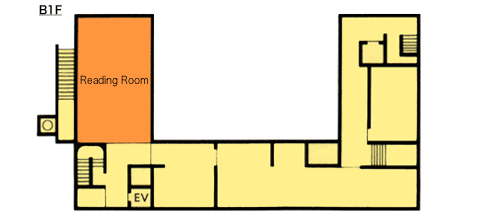 |
Reading Room:
A wide range of Yokohama-related historical materials in the Archives' collection is available to facilitate research. Researchers have especially easy access to documents and books on Yokohama, reference books, and newspapers up to the Taisho period, available in reproductions, including the Yokohama Mainichi Shimbun (the first Japanese daily newspaper), the Yokohama Boeki Shimbun (Trade News) and various English-language newspapers. The trained staff provide reference service. Copy service is also available.
Collections:
The Yokohama Archives of History contain over 250,000 Yokohama-related materials from the Edo period to the Taisho-early Showa era.
1.Government-related materials
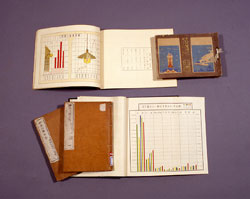 The Yokohama City Government lost the majority of its official documents in the Great Kanto Earthquake and Fire of 1923 and during World War II air raids in 1945. The Archives have compensated for the loss by collecting documents such as printed stenographic records of the Yokohama City Council and the Kanagawa Prefectural Assembly, and bulletins and official statistics published by Yokohama City or Kanagawa Prefecture.
The Yokohama City Government lost the majority of its official documents in the Great Kanto Earthquake and Fire of 1923 and during World War II air raids in 1945. The Archives have compensated for the loss by collecting documents such as printed stenographic records of the Yokohama City Council and the Kanagawa Prefectural Assembly, and bulletins and official statistics published by Yokohama City or Kanagawa Prefecture.
2.Overseas and Foreign Settlement materials
The Archives have collected diplomatic documents of the U.K., the U.S., and France among countries that influenced Japan since the late Edo period, church missionary reports, and personal documents of Japan-based diplomats. These materials help us see Yokohama and Japan from foreign viewpoints. Also, the directory of foreign residents and trading companies is an important source of information about the Yokohama Foreign Settlement.
3.Materials related to local leaders
In the Edo period there were more than two hundred villages in what is now Yokohama. Farmers called "Village Officers" administered villages and kept records. In the Meiji era, village headmen and leaders of various local organizations left many official and personal records. Those materials are crucial to our understanding of regional conditions in those days.
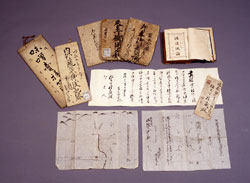 |
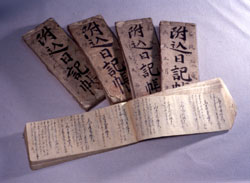 |
4.Materials related to Yokohama Merchants
Upon the opening of Yokohama Port, wealthy farmers in raw-silk-producing regions such as Gunma and Nagano began trading in Yokohama and became successful silk exporters. They are called the "Yokohama Merchants." The Archives have collected such materials as letters and memos to their acquaintances in home regions. These materials recount the growth and the evolution of those merchants.
5.Newspapers and magazines
Yokohama is known as the place where Japan's first daily newspaper was published. The Archives hold various newspapers in Japanese and foreign languages, and magazines published in Yokohama since the late Edo period. The Archives also possess collections of newspapers published in the U.K., France and China in the nineteenth century. These are important sources of information regarding the world situation during the period when Yokohama was opened.
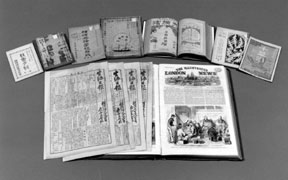 |
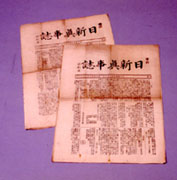 |
6.Pictorial materials
Nishikie (colored wood block prints), photos, and picture postcards give vivid images of the scenery and the culture of Yokohama from the port opening period to the Meiji-Taisho era. Also, the Archives contain maps, kawaraban newssheets, programs of popular plays, raw silk and tea trademarks, and building blueprints.
 |
|
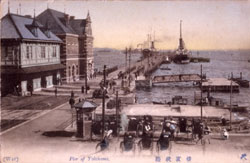 |
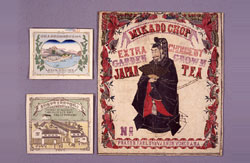 |
7.Special collections
The Archives possess several collections on different themes. The Paul C. Blum Collection and Don Brown Collection contain foreign books and magazines about Japan. The A. Neil Pedlar Collection is a collection of picture postcards of Meiji and Taisho Japan. The Gomi Kametaro Collection consists of Yokohama-related materials from the port opening period. The Oka Collection comprises items from daily life in the Meiji and Taisho eras.
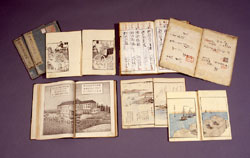 |
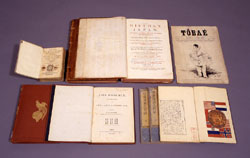 |

